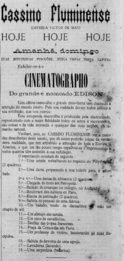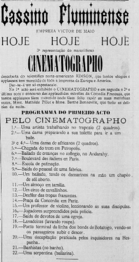Vittorio Di Maio (lost films from Italian director; existence unconfirmed; 1897)
Vittorio Di Maio was an Italian pioneer in film exhibitions in Brazil. In 1897, he supposedly recorded films that years later were considered the first films produced in Brazil.[1]
On the 1st and 6th of May 1897, Vittorio Di Maio exhibited 22 films at the Teatro Cassino Fluminense. The exhibitions can be confirmed in advertisements in the newspaper "Gazeta de Petrópolis".[2] [3] These films were for a long time considered the first films produced in Brazil.
Controversies
Di Maio could not have made these shorts, as he only worked with projection devices that are still unknown today, and it would have been extremely complicated for the time, because there was no cinematographic material available.
The researchers Paulo Roberto Ferreira and Jorge J.V. Capellaro, in the book "Verdades Sobre o Início do Cinema no Brasil" argue the short films exhibited in 1897 are Brazilian. The only evidence raised by the researchers is the fact that the titles of some films refer to places in Brazil, such as "Petrópolis" and "Polytheama".[4]
However, other researchers indicate that Di Maio changed the titles of foreign films to deceive the population of Petrópolis. Another thing that reinforces the theory is that Di Maio never mentioned or explained the screenings or the whereabouts of the films, even before he died in 1926.
List of Films
Of all 22 films exhibited, only 4 are defended as being Brazilian, which as:
- Uma Artista Trabalhando no Trapézio do Polytheama
- Chegada do Trem em Petrópolis
- Bailado de Crianças no Colégio, no Andaraí
- Ponto Terminal da Linha de Bondes de Botafogo, Vendo-se os Passageiros Subir e Descer
Uma Artista Trabalhando no Trapézio do Polytheama
Film that supposedly showed an artist working on the Polytheama trapeze. The only proof that this was a Brazilian film would be the existence of theaters with name "Polytheama" or "Politeama", within from the regions of Rio de Janeiro and São Paulo.
Several theater names were known, such as the "Politeama Nacional do grupo Antártica" in São Paulo and "Politeama Fluminense" in Rio de Janeiro. In the theaters, various presentations, lyrical groups, ballets, trapeze artists and festivities took place, this fact would make it possible for Di Maio to be recorded for the film, but it is unlikely.
According to research, the film could be the 1894 American film "Contortionist", by William K.L. Dickson.
Chegada do Trem em Petrópolis
Film that supposedly showed a train arriving at a station in Petrópolis. The only proof that this film was Brazilian is the title that contains "Petrópolis", which is a municipality in Rio de Janeiro.
According to research, the film could be the film "Arrivée dun train à La Ciotat" by Auguste e Louis Lumière, or "L Arrivée du train en gare d Asnières", by Ernest Normandin, both from 1896.
Bailado de Crianças no Colégio, no Andaraí
Film that supposedly showed a children's dance at school, in Andaraí. The film is listed as being a Brazilian film, but there is no evidence to confirm that this film is a Brazilian production.
According to research, the film could be the 1896 film "Bal d'enfants", by Louis Lumière.
Ponto Terminal da Linha de Bondes de Botafogo, Vendo-se os Passageiros Subir e Descer
Film that supposedly showed a terminal point on the Botafogo Tram Line, where passengers could be seen getting on and off.
According to research, the film could be the 1896 film "Berlin: Hallesches Thor", directed by Auguste and Louis Lumière.
Gallery
Images
See Also
Brazilian Films
- Acabaram-se os Otários (partially found Brazilian comedy film; 1929)
- Amazonas, o Maior Rio do Mundo (found Brazilian documentary film; 1918-1920)
- Luiz de Barros (partially found films from Brazilian director; 1916-1980)
- Nhô Anastácio Chegou de Viagem (lost Brazilian first comedy film; 1908)
- O Kaiser (lost Brazilian first animated film; 1917)
- Os Óculos do Vovô (partially found Brazilian film; 1913)
- Presente de Natal (partially found Brazilian animated film; 1971)
- Um Crime Sensacional (lost Brazilian drama film; 1913)
- Vocação Irresistível aka "The Most Mysterious Film in Brazil" (lost Brazilian comedy film; 1924)
References
- ↑ Article that cites Di Maio as being responsible for the first recordings made in Brazil.
- ↑ First advertisement in the newspaper "Gazeta de Petrópolis".
- ↑ Second advertisement in the newspaper "Gazeta de Petrópolis".
- ↑ Verdades Sobre o Início do Cinema no Brasil, book written by Roberto Ferreira and Jorge J.V. Capellaro.


